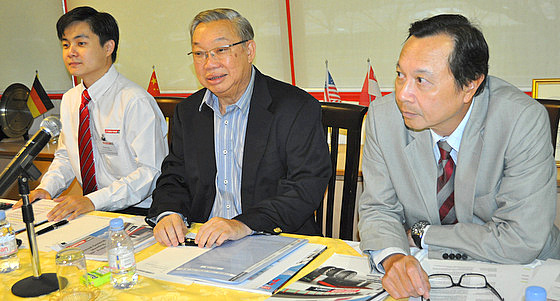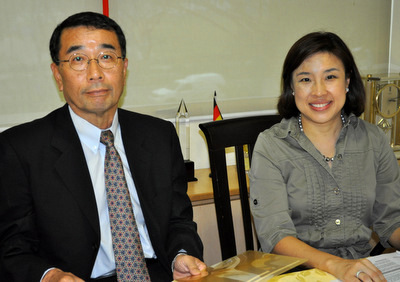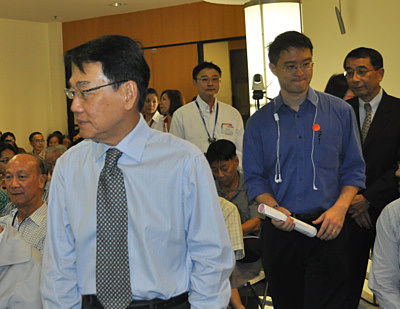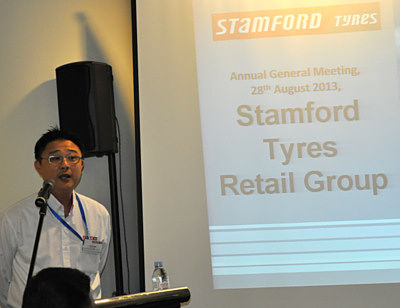 L-R: Group Finance Manger Frank Ng, President Wee Kok Wah and Non-Executive Chairman Sam Chong Keen.
L-R: Group Finance Manger Frank Ng, President Wee Kok Wah and Non-Executive Chairman Sam Chong Keen.
 Time & date: 3 pm, Aug 28, 2013.
Time & date: 3 pm, Aug 28, 2013.
Venue: 19, Lok Yang Way
 Executive V-P Dawn Wee with Senior Adviser Chua Kim Yeow.Photos by Allison Chen
Executive V-P Dawn Wee with Senior Adviser Chua Kim Yeow.Photos by Allison Chen
STAMFORD TYRES, as in previous years, attracted a strong turnout of shareholders to its AGM, many of whom caught the company's special shuttle from Joo Koon MRT station to its office in Lok Yang Way.
And once again, Stamford Tyres did what shareholders wish many other companies would do at AGMs: Give a Powerpoint presentation on its business highlights of the year.
(Net profit attributable to shareholders was up 18.5% to $11.6 million and an unchanged final dividend of 1.5 cent a share was proposed.)
At the end of the event, shareholders were treated to a sumptuous buffet comprising of, among others, mee siam, satay, kambing soup, fresh fruits... and even red wine.
Some highlights of the presentation and the Q&A session:
 Independent director Kazumichi Mandai with Non-Executive Director Dr Wee Li Ann.1. Strategy and outlook: President Wee Kok Wah said the company would continue to "defend the gross profit margin at above 20%."
Independent director Kazumichi Mandai with Non-Executive Director Dr Wee Li Ann.1. Strategy and outlook: President Wee Kok Wah said the company would continue to "defend the gross profit margin at above 20%."
The company could enjoy lower prices for its tyre purchases as raw material and commodity prices have softened.
And it would grow its value-add segments such as Stamford Tyres Mart retail chain and truck centres, which generate good margins, and continue to cut operating costs.
Stamford Tyres, he said, could continue to enjoy organic growth of 5% - 10% in its revenue, especially with new markets -- South Africa and India -- contributing more sales going forward.
Giving an update on the company's 40-60 joint venture with Sumitomo Rubber in India, Mr Wee said that 300 dealers have been appointed since the JV was formed a year ago. Sales began in April this year.
 L-R: Independent director Tay Puan Siong; research analyst Linus Loo of Lim & Tan Securities.
L-R: Independent director Tay Puan Siong; research analyst Linus Loo of Lim & Tan Securities.
"The main advantage of this deal is that the tyres are made locally on an offtake arrangement and priced in Indian rupees, which means we can avoid foreign exchange issues."
2. Forex exposure: Stamford Tyres had a forex loss of S$1.65 million in FY13, down from S$3.56 million in FY12.Mr Wee said forex risks are part and parcel of the Group's business. The Board has to decide if it would reduce inter-company loans and get its local operations to increase borrowings from local institutions, for example, instead of being funded by HQ in Singapore dollars.To a question, Mr Frank Ng, group finance manager, said S$2m of the S$3.1 m loss in South Africa was due to forex losses.  Independent directors Goh Chee Wee and Leslie Mah.Non-executive chairman Sam Chong Keen said the Board had spent a considerable amount of time discussing South Africa. It recognised that forex risk could not be eliminated in overseas ventures but it has a strategy to mitigate the risks. In addition, management changes have been made ("A good manager overseas can make a lot of difference to the operations") and the Board is hopeful of an improvement in the business.3. Southeast Asia: On the profit drop from S$12.4 million in FY12 to $6.4 m in FY13 in Southeast Asia, Mr Wee said $2.8 million had to be written off from the residual value of the old warehouse in Singapore prior to it being redeveloped. Another S$3 million was due to lower sales.4. Valuation of assets: To a question on the market value of Stamford Tyres' HQ and the new warehouse next to it, Mr Sam said the company had not called for a valuation report on them and had no plan to do so. But he acknowledged that industrial properties have risen in value over the years.
Independent directors Goh Chee Wee and Leslie Mah.Non-executive chairman Sam Chong Keen said the Board had spent a considerable amount of time discussing South Africa. It recognised that forex risk could not be eliminated in overseas ventures but it has a strategy to mitigate the risks. In addition, management changes have been made ("A good manager overseas can make a lot of difference to the operations") and the Board is hopeful of an improvement in the business.3. Southeast Asia: On the profit drop from S$12.4 million in FY12 to $6.4 m in FY13 in Southeast Asia, Mr Wee said $2.8 million had to be written off from the residual value of the old warehouse in Singapore prior to it being redeveloped. Another S$3 million was due to lower sales.4. Valuation of assets: To a question on the market value of Stamford Tyres' HQ and the new warehouse next to it, Mr Sam said the company had not called for a valuation report on them and had no plan to do so. But he acknowledged that industrial properties have risen in value over the years.  John Ang, vice-president (retail), gave a rundown on the company's retail outlets and services in Singapore.Would the company sell the assets to a REIT, lease them back, and use the proceeds to develop its core distribution business? Mr Sam said the Board's view is that REITs would be looking at 5-6% yields which implies that Stamford Tyres would then have significant rental costs.Added Mr Wee: "We have not revalued our properties. We just buy when prices are low and sell when they are high." (Subsequent to the AGM, the company announced the sale of a retail shop, #01-13 Balestier Towers, for $6.3 million. It had a net book value of S$727,846 and had been leased out to an unrelated party since 2009).Next question: "Some companies said that one year's rent in Singapore can buy a freehold property in Iskandar. Will you capitalise on that to save on costs?"Mr Wee replied: "Singapore is a free port -- no tax for imports, no VAT on our re-exports, so there is a big plus being here. And to haul from Iskandar out to Singapore, you need bonded trucks and such licences are issued in a limited way in Malaysia."
John Ang, vice-president (retail), gave a rundown on the company's retail outlets and services in Singapore.Would the company sell the assets to a REIT, lease them back, and use the proceeds to develop its core distribution business? Mr Sam said the Board's view is that REITs would be looking at 5-6% yields which implies that Stamford Tyres would then have significant rental costs.Added Mr Wee: "We have not revalued our properties. We just buy when prices are low and sell when they are high." (Subsequent to the AGM, the company announced the sale of a retail shop, #01-13 Balestier Towers, for $6.3 million. It had a net book value of S$727,846 and had been leased out to an unrelated party since 2009).Next question: "Some companies said that one year's rent in Singapore can buy a freehold property in Iskandar. Will you capitalise on that to save on costs?"Mr Wee replied: "Singapore is a free port -- no tax for imports, no VAT on our re-exports, so there is a big plus being here. And to haul from Iskandar out to Singapore, you need bonded trucks and such licences are issued in a limited way in Malaysia."
Recent articles:
 L-R: Group Finance Manger Frank Ng, President Wee Kok Wah and Non-Executive Chairman Sam Chong Keen.
L-R: Group Finance Manger Frank Ng, President Wee Kok Wah and Non-Executive Chairman Sam Chong Keen.  Time & date: 3 pm, Aug 28, 2013.
Time & date: 3 pm, Aug 28, 2013. Executive V-P Dawn Wee with Senior Adviser Chua Kim Yeow.Photos by Allison Chen
Executive V-P Dawn Wee with Senior Adviser Chua Kim Yeow.Photos by Allison Chen NextInsight
a hub for serious investors
NextInsight
a hub for serious investors











Previously, President kept drumming about NAV being more than 50 cents....